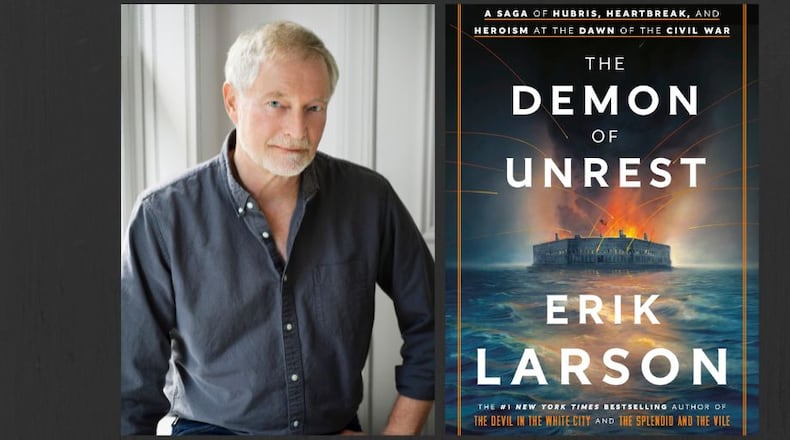Erik Larson was well into his research into the divisions that led to the Civil War when he watched the assault on the U.S. Capitol on Jan. 6, 2021. He writes in a foreword to his new book that as he watched it live, he had “the eerie feeling that the present and past had merged.”
It’s the only time he mentions Jan. 6 in “The Demon of Unrest,” but that merging, what the poet Seamus Heaney called the rhyme of history, pervades this timely volume.
Ever since he published his 2003 bestseller “The Devil in the White City,” Larson has been one of the biggest brands in narrative history, and his books shoot to the top of the bestseller list as if fired from a mortar. Where “White City” dealt with a little-known story about the 1893 Chicago World’s Fair, his recent works have moved to ground that has been tilled and re-tilled by historians: two books about the beginning of World War II and now the Civil War.
Even history buffs who are familiar with Ken Burns’ PBS documentary, Mary Chesnut’s oft-quoted 400,000-word diary and Lincoln’s strange social awkwardness will find much that is new here. If Larson’s subjects in “Demon” are not always new, he brings a welcome novelist’s sensibility to his writing. He has an eye for telling details, quick and potent character descriptions and a relentless narrative momentum that starts at a brisk canter on Election Day in 1860 and moves to a full gallop as North and South clash over Fort Sumter and our common future.
The title comes from a letter from a professor at West Point, noting that changing economic forces and the impending decline of agrarianism had unleashed a “demon of unrest” in the South. The demon whispered to the wealthy white Southerners that their days of owning slaves were numbered. Although Lincoln had not campaigned to end slavery and was reluctant to even talk about the topic publicly, his election in 1860 whipped those fears into a frenzy that culminated with the bombardment of the fort in Charleston Bay.
“Demon” covers just a few months, from November 1860 to April 1861, and the action shifts back and forth between Washington, D.C., and Fort Sumter in South Carolina. In D.C., President James Buchanan longs for the end of his term and generally makes the worst of his bad choices. In Fort Sumter, Major Robert Anderson begs for orders on whether to protect his 75 outgunned troops in case of an attack and how to go about it. (Anderson, rather than Lincoln, could fairly be called the true hero of “Demon.”)
Lincoln, meanwhile, travels to his inauguration in disguise, stooping to hide his enormous height, because the detectives hired to protect him have heard stories of plots to assassinate him. His staff fears that the Senate will find some pretext to nullify the counting of the electoral votes.
Larson emphasizes Lincoln’s naivete about how committed the South was to war, even as states started to secede before he was even inaugurated. His disposition, nevertheless, led to one of the most beautiful passages in American oratory at that inauguration:
“We must not be enemies. Though passion may have strained, it must not break our bonds of affection. The mystic chords of memory, stretching from every battlefield and patriot grave to every living heart and hearthstone all over this broad land, will yet swell the chorus of the Union, when again touched, as surely they will be, by the better angels of our nature.”
Quoting Southern letters and speeches, Larson makes it clear that the war was fought because the South wanted to preserve slavery; the “states’ rights” in question were mainly the right to own people. He points out the contradictory positions the South took: that slaves were happy and well-treated, but also always on the verge of rising up and slaughtering their masters.
He digs into the importance of chivalry and the sense of honor among the planter class, quoting often from the Code Duello, the set of rules that governed how duels were to be fought and emphasized chivalry. (Klan members originally conceived of themselves as Knights.)
On April 14, 1865, five days after the Battle of Appomattox Court House and after the deaths of 750,000 Americans, Lincoln ordered Anderson to return to Sumter, the fort he had been forced to surrender. In front of a crowd of about 5,000, Anderson raised the very same American flag he had lowered four years previously over Sumter once again. That same night, Lincoln was assassinated by a Confederate sympathizer.
Not long ago I took the morning ferry from Charleston to Fort Sumter, where the National Park Service holds a flag-raising ceremony daily at 10:30 a.m. A park ranger gave a moving and accurate history of the fort and the events of 1861, and then invited tourists to help raise the large American flag. About 20 of us held the four sides waist high, parallel to the ground, then a tourist who had served in the armed forces yanked on a rope.
The flag practically leapt from our hands and sped up the high flagpole, where it flapped and popped boldly in the wind. Looking up at it, at least for that moment, the demons of unrest seemed at bay.
NONFICTION
“The Demon of Unrest”
By Erik Larson
Crown Publishing, 592 pages, $35.
About the Author
Keep Reading
The Latest
Featured



